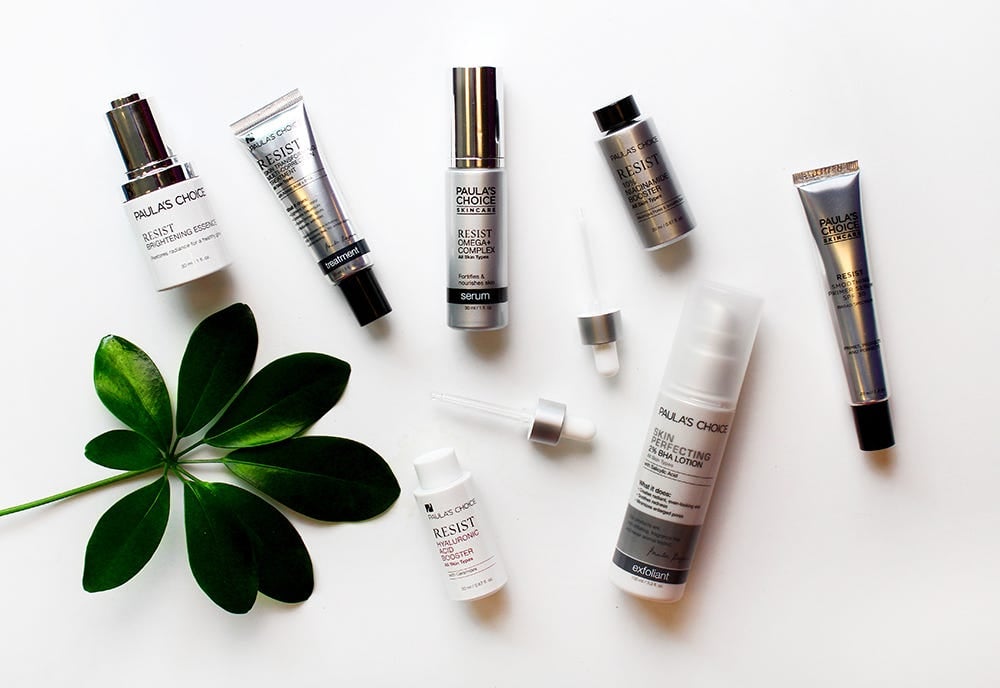
Whether you’re still trying to get to grips with a dedicated skincare regime, or are a self-confessed skincare junkie (uhmm, we’re deffo the latter) you may have heard about the various skincare acids that are getting all the attention when the topic of skincare arises – they’ve become super popular and it’s smart to know about ‘em. If you’ve got all the other lotions and potions down but don’t know what you should be doing with acids, don’t fret – just check out our handy Beginner’s Guide to Skincare Acids.
Did you know that there’s an acid for every skin type and concern? Yes, really. All facial acids have their own benefits but it’s important to know which are best for you before messing around with your skin. The word acid doesn’t exactly have the best connotations, but we’d like to stress that these particular acids are not the type to a) burn you from the inside out, or b) induce a series of trippy hallucinations – instead you’ll be well on your way to a clearer, glowing complexion.
Still wondering what all the fuss is about? Here at LiB, we’re all acid activists and our skincare cabinets are bursting (no, literally, we can’t close the door) with the latest ingredients that we just *had to* try, therefore we’re going to explain how the most common skincare acids work, how to use them and which of our fave products you can find them in.
PH IS IMPORTANT
Without boring or confusing you too much with the science, it’s interesting to see the importance of pH in relation to skincare, and especially acid products. When PKA (acid availability) is close to pH (power of hydrogen ions), there is an ideal balance between salt and acidity, maximising the effectiveness of the acid and reducing irritation. Higher pH numbers in such a case would increase salt, which would counter-intuitively make the formula even more irritating than if it was more acidic. As an example, 10% glycolic acid with few ingredients and a low pH would be more effective than a 10% glycolic toner with a higher pH and more ingredients, as the extra ingredients would buffer the strength of the acid. An acid product is only as effective as the free acid compounds it’s made up of, and pH is more valid than percentage. Anything below a pH of 7.0 is considered an acid, and remember that the skin is already acidic, with a pH ranging from 4.5-5.5.
THE BREAKDOWN
Glycolic Acid
We’re sure you’ve heard many things about this particular acid, and have seen it on the ingredients list of many cult products (including our faves: Pixi Glow Tonic and Alpha- H Liquid Gold). Glycolic acid falls into the AHA family (alpha hydroxy acid) and is one of the weaker acids that works as a chemical exfoliator – an alternative to manual exfoliating scrubs (they were so 90s). Glycolic acid is the smallest of the AHAs, making it more effective at penetrating the skin. This acid dissolves the substance that holds cells together and breaks down the top layer of the skin to reveal a youthful and radiant glow. Suitable for all skin types (including sensitive skin), glycolic is derived from the sugarcane and gently and slowly lightens hyper-pigmentation, uneven skin tone and sun spots while treating acne, fading blemishes, reducing fine lines and brightening skin. By lowering skin’s pH, glycolic additionally stimulates cellular activity – accelerating the skin’s repair and renewal processes. Use of AHA’s should be followed with a high protection SPF for at least one week after use, as these acids may increase your skin’s sensitivity to the sun.
Lactic Acid
This is another type of AHA, found in sour milk, which is particularly effective for those with acne scarring. Lactic acid is also weaker in strength and exfoliates the skin gently while speeding up cell turnover. Lactic increases moisture in the skin, and although not as good at treating premature signs of ageing, is ideal for sensitive, dehydrated and tired skins as it works in tandem to moisturise and buff away dead skin cells. Ideally, this acid should be used in the PM and can be diluted to reduce the strength until skin develops tolerance. It’s also worth noting that this acid doesn’t thin the skin, however it should still be followed by an SPF. Our recommendations? Bravura London’s Lactic Acid 10% or The Ordinary’s Lactic Acid 10% + HA 2%.
Citric Acid
Another AHA, citric acid is derived from citrus fruits. It’s ideal for hyper-pigmented skin with dark spots. This acid speeds up cell renewal and balances the skin’s pH while acting as a natural skin exfoliator. It’s a wonder product for several skin problems, including mild acne, pigmentation, clogged pores, dark spots and wrinkles.
Salicylic Acid
AKA the acne buster! Derived from plants, salicylic acid is a BHA (beta hydroxy acid) that works to draw out impurities instead of drying them out. Suited to combination, oily or acne-prone skin, salicylic acid exfoliates the skin, clears pores and treats breakouts while building elastin and collagen and reducing excess oil and congestion. Typically, salicylic is often found in small concentrations in many spot treatments. Super Facialist by Una Brennan’s Salicylic Acid Anti-Blemish Pore Purifying Clay Mask is a firm fave in our office for unclogging pores and letting skin breathe, however we’re also partial to the higher concentration from Paula’s Choice 2% BHA Lotion. Salicylic acid is not recommended for mature or dry skin, unless specifically targeting problematic spots.
L’Ascorbic Acid
Vitamin C in its purest form. This superstar ingredient is as good for the skin as oranges are for the body. When used in your skincare routine, vitamin C provides many benefits, including evening out skin tone, shielding skin from visible impacts of pollution and UV damage, stimulating collagen and hydrating and brightening the skin; keeping you looking younger for longer. Its proven antioxidant properties boost and firm the skin, lending the appearance of fullness to the face while easing wrinkles and fine lines. The acid can be used morning or night, however in its most stable form (like The Ordinary’s Vitamin C Suspension 23%), we recommend using at night.
Hyaluronic Acid
The least ‘scariest’ acid of ‘em all. It’s not one that will make you shed dead skin or peel, but brings all the moisturising powers. Hyaluronic acid is a natural humectant that is found in the skin that has the capacity to attract and retain large amounts of moisture (up to 1,000 times its own weight in water). It helps to strengthen your skin’s barrier so that it becomes softer, smoother and plumper. Hyaluronic is suitable for all skin types and has a gel-like texture, making it a great option for hydrating oily skin without clogging pores. The molecular size of HA determines its depth of delivery in the skin so products that have varying or lower molecular weights are the ones to opt for. Our ‘go to’ is The Ordinary’s Hyaluronic Acid 2% + B5, or if we’re after a quick fix, Indeed Labs’ Hydraluron Moisture Boosting Mask.
Retinol
Not technically an acid, but we thought this trending skincare ingredient – a “skincare miracle” if you will – was worth a mention. An ingredient hyped for its age-busting, complexion-enhancing power, this derivative of Vitamin A is an effective exfoliant that encourages the skin to shed dead skin to turn over healthier cells. The use of retinol can improve skin firmness while turning back the time on sun and environmental damage, all while treating acne, hyperpigmentation, dark circles, and signs of ageing (most commonly, lines and wrinkles). When retinol is topically applied to the skin, enzymes work to convert it into retinoic acid, improving common skin complaints and revitalising the skin. The prescription alternative (retinoic acid, or Retin-A) acts fastest but can be drying, and the process of converting retinol into retinoic acid can take a number of weeks. Retinol products are also safe to use with AHA’s and BHA’s as the latter take care of the top layers of the skin, while retinol works at a deeper level. In the words of Caroline Hirons, “The acid holds the door open for the retinol to pass by…retinols are cell communicators”. Just remember, everybody’s skin is different, so if you’re flaking or peeling considerably with retinol and are attempting to combine with acids, the concoction could be too strong for your skin. Retinol products worth noting are Paula’s Choice 1% Retinol Treatment, Super Facialist’s Retinol+ Anti-Ageing Restoring Serum, The Ordinary’s Retinol 1% and Image Skincare’s Ageless Overnight Retinol Masque.
Nothing is better than a fresh batch of skincare, is there? Check out our selection of skincare in our Build Your Own section or head on over to our Twitter page to be in with a chance of winning a bundle of Paula’s Choice skincare.






